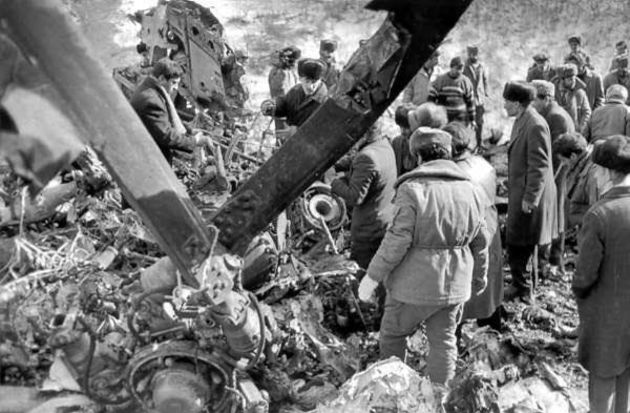"We are talking about the inevitability of punishment, the inevitability of responsibility ... Everyone should be responsible for what he did and everyone who is guilty should be prosecuted." These are the words of the first Prosecutor General of the Republic of Azerbaijan, Ismet Gaibov, from his last interview. He consistently defended the rule of law over politics. Exactly 30 years ago, on November 20, 1991, he was killed along with other key figures of Azerbaijan that had just restored its independence. Their death became one of the central events in the flaring up Nagorno-Karabakh conflict, as it prevented a quick solution to the problem, which by the end of autumn 1991, had just begun to develop into a war. The organizers and perpetrators of this terrorist act, which opened the way for the Karabakh war, have not yet been brought to justice.
On Wednesday 20 November 1991, the Secretary of State of the Republic of Azerbaijan Tofig Ismailov, Interior Minister Magomed Asadov, Deputy Prime Minister Zulfi Hajiyev and Prosecutor General Ismet Gaibov boarded a Mi-8 helicopter of the USSR Ministry of Internal Affairs with tail number 72 in Aghdam. Two days earlier, in Baku, a request was received from the Kremlin, from the personal assistant of Mikhail Gorbachev, to hold the meeting of the Security Council of the Azerbaijan Republic in the not yet disbanded Nagorno-Karabakh Autonomous Oblast (it would be liquidated by the Supreme Soviet of Azerbaijan six days later). The goal was the settlement of the Armenian-Azerbaijani problem; mediators from Moscow and representatives of the Karabakh separatists were to participate in the Security Council meeting.
Therefore, the head of the MNS department for the NKAO Sergey Ivanov, the head of the NKAO department of internal affairs, Vladimir Kovalev, the NKAO prosecutor, Igor Plavsky, the deputy commander of the Transcaucasian military district, the NKAO military commandant, Nikolai Zhinkin, - that is, the entire leadership of the Karabakh power block not linked with separatists boarded the same helicopter. Together with them, there were deputies Vagif Jafarov and Veli Mamedov, head of the Presidential Administration of the Republic of Azerbaijan Osman Mirzoev, First Deputy Minister of Land Reclamation Gurban Namazaliev, Assistant Secretary of State Rafik Mamedov, Deputy Minister of Internal Affairs of Kazakhstan Sanlal Serikov, Police Major General Mikhail Lukashov, Lieutenant Colonel Oleg Kocherev went to the meeting of the Security Council, media representatives Aly Mustafayev, Fakhraddin Shahbazov and Arif Huseynzade. The crew consisted of Vyacheslav Kotov, Gennady Domov and Dmitry Yarovenko, 22 people in total.
Since the day before there were clashes in Khojavend, it was decided to fly there to deal with the problem directly on the ground. At 14:05, communication with the helicopter was lost, it disappeared from the radar. Only six hours later it was found out that it had been fired upon from machine guns and shot down by a rocket at an altitude of 300 m, three kilometres from the village of Garakend, located on the way between Agdam and Khojavend.
Those who organized this crime, in fact, inflicted a blow not only on Azerbaijan but throughout the region. Representatives of the central Azerbaijani government, the leaders of the NKAO power bloc, and delegates from Russia and Kazakhstan, killed in the skies over Garakend, worked to resolve the Armenian-Azerbaijani conflict before the separatists and Yerevan had the opportunity to turn it into a destructive war, and thereby stop the socio-political crisis in Azerbaijan. After the deaths of Tofig Ismailov, Magomed Asadov, Zulfi Hajiyev, Ismet Gaibov and others, the destructive forces, who wanted war between Armenia and Azerbaijan, were untied.
The very next day, on November 21, the first deputy commander-in-chief of the internal troops of the USSR Ministry of Internal Affairs, Major General Vyacheslav Ponomarev arrived in Agdam to investigate the crime. Representatives of the USSR Prosecutor General's Office and the Chief Military Prosecutor's Office also took part in the investigation. The NKAO said that the helicopter hit a rock, but a study of the scene of the attack showed that the helicopter's fuselage was torn apart by a rocket explosion, and bullets of large-calibre automatic firearms remained in the helicopter and the bodies of the dead.
The surviving black boxes confirmed that illegal armed formations of Karabakh separatists fired at the helicopter from the ground. The Ministry of National Security of Azerbaijan qualified the crime as a terrorist attack. Armenia protested, stating that there was an accident, the separatists also denied their guilt. Rallies began in Baku demanding the resignation of President Ayaz Mutalibov or the restoration of order in Karabakh.
Before long, it became impossible to continue the investigation of the terrorist attack, since the helicopter crash site was captured by the army of the Republic of Armenia. The black boxes were sent to Moscow, but along the way their integrity was violated, some of the data was erased. As a result, today, 30 years later, the terrorist attack in the skies over Garakend remains one of the tragic secrets of the modern history of Azerbaijan and one of the key events on the way to the occupation of 20% of Azerbaijani territories, which lasted until the fall of 2020.






